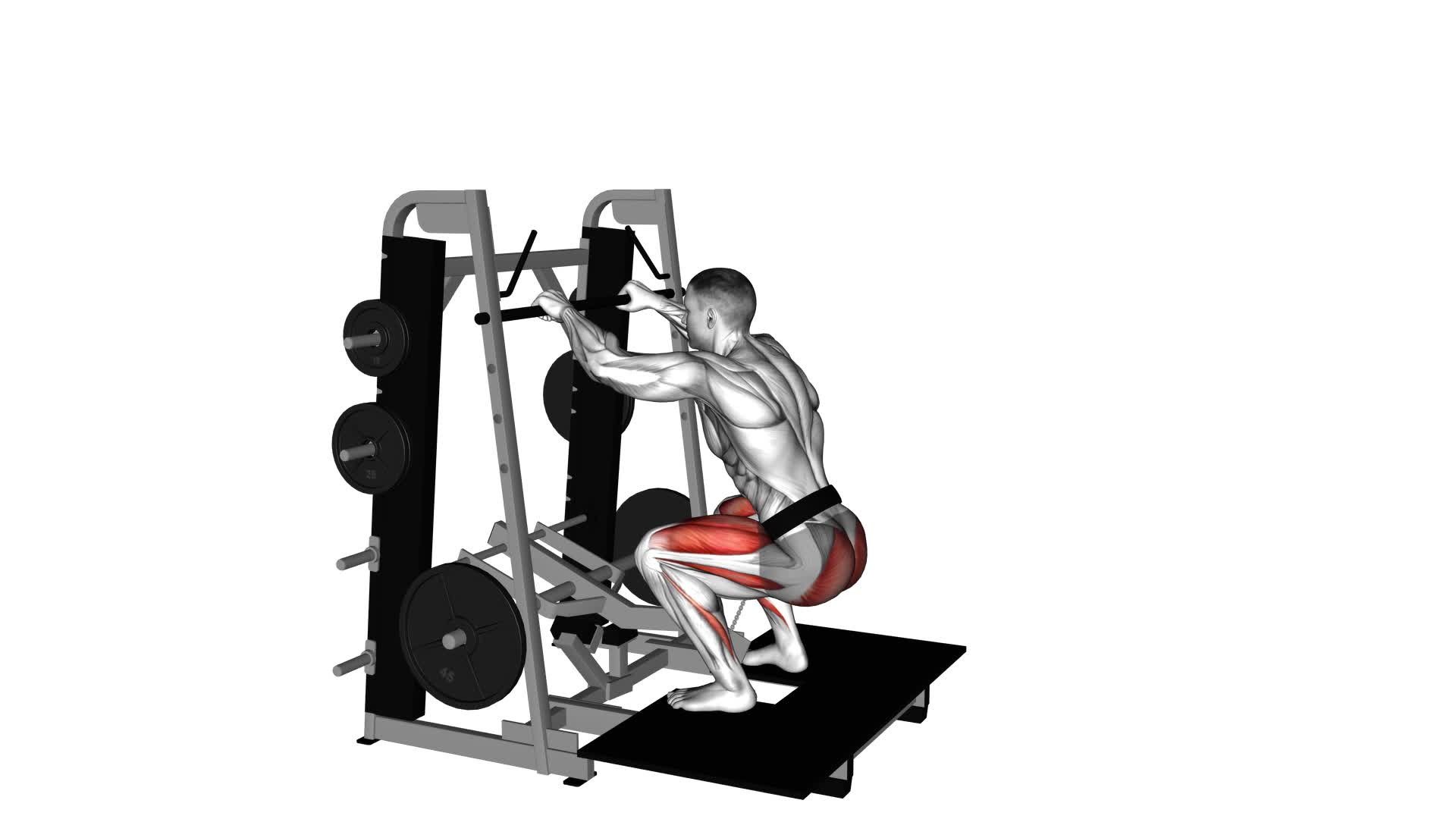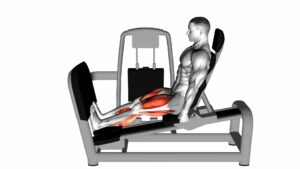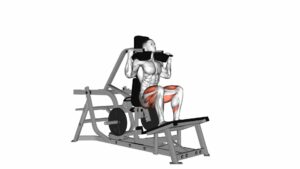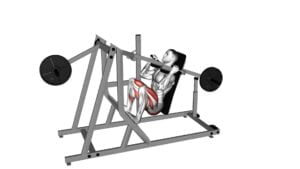Lever Belt Squat – Video Exercise Guide & Tips

Looking to add a new exercise to your routine? Check out the Lever Belt Squat!
Watch This Exercise Video
This video exercise guide and tips will show you how to properly set up and perform the exercise. Avoid common mistakes and learn how to increase intensity for maximum results.
With this informative and concise guide, you'll be on your way to mastering the Lever Belt Squat in no time. Let's get started!
Key Takeaways
- Activates muscles in the lower body, including quadriceps, hamstrings, glutes, and core
- Provides a safer alternative for individuals with back or spine issues
- Proper belt positioning and alignment are crucial for maximizing the benefits of the exercise
- The right equipment enhances performance and reduces the risk of injury
Benefits of the Lever Belt Squat
Experience the numerous benefits of the Lever Belt Squat for a stronger lower body and improved overall strength. This exercise is highly effective in activating your muscles, especially in the lower body. The Lever Belt Squat engages your quadriceps, hamstrings, glutes, and even your core muscles. By increasing the load on these muscles, you can achieve improved muscle activation and ultimately, greater strength gains.
One of the advantages of the Lever Belt Squat is the ability to modify and vary the exercise to suit your specific needs and goals. You can adjust the weight and resistance according to your fitness level and gradually increase the intensity as you progress. Additionally, the Lever Belt Squat allows for variations in foot placement, such as wide or narrow stances, targeting different muscles and enhancing muscle activation in those areas.
Furthermore, the Lever Belt Squat provides a safer alternative to traditional back squats for individuals with back or spine issues. By using a belt to support your body, you can reduce the strain on your lower back while still achieving a challenging workout. This modification allows you to focus on strengthening your lower body without compromising your overall health.
Proper Set-Up and Equipment for the Exercise
To properly set up for the lever belt squat, it's important to focus on belt positioning and alignment.
Make sure the belt is secured around your waist, just above your hips, and tightened to provide support during the exercise.
Additionally, choosing the right equipment, such as a lever belt that fits properly and allows for easy adjustments, is crucial for maintaining proper form and maximizing the benefits of the exercise.
Belt Positioning and Alignment
Place the lever belt around your waist, ensuring proper alignment and positioning for the exercise.
When wearing the belt, it's important to consider the tightness. The belt should be snug enough to provide support and stability, but not so tight that it restricts your breathing or movement. Finding the right balance is crucial to maximize the benefits of the lever belt squat.
Additionally, it's worth noting the difference between a lever belt and a regular belt. A lever belt is designed with a lever mechanism that allows for quick and easy adjustment, providing a secure fit during the exercise. On the other hand, a regular belt requires manual adjustment and may not offer the same level of convenience and support as a lever belt.
Choosing the Right Equipment
To ensure proper set-up and equipment for the lever belt squat, start by selecting the right gear for your workout. Here are four key considerations:
- Weightlifting Shoes: Invest in a pair of weightlifting shoes with a raised heel. This will help improve your squat mechanics and provide stability and support during the exercise.
- Lever Belt: Choose a lever belt that fits snugly around your waist. This belt will provide additional support and stability to your core while performing the squat.
- Alternative Exercises: If you don't have access to a lever belt or weightlifting shoes, there are alternatives you can try. For example, you can use a regular lifting belt and wear flat-soled shoes for stability.
- Safety Equipment: Don't forget to prioritize safety. Consider using knee sleeves or wraps to protect your knees during the squat.
Now that you have the right equipment, let's move on to the step-by-step guide to performing the lever belt squat.
Step-by-Step Guide to Performing the Lever Belt Squat
Start by positioning yourself in front of the lever belt squat machine. The lever belt squat is a highly effective exercise that targets your lower body muscles, including your quadriceps, hamstrings, and glutes. It also helps to improve your core strength and stability.
To perform the lever belt squat correctly, begin by stepping onto the platform and adjusting the height to match your comfort level. Position your feet shoulder-width apart, with your toes slightly turned out. Engage your core and grip the handles for stability.
Slowly lower your body by bending at the knees and hips, keeping your back straight and your chest up. Descend until your thighs are parallel to the ground, or as low as your flexibility allows. Pause briefly at the bottom, then push through your heels to lift your body back up to the starting position. Remember to maintain proper form throughout the movement and avoid rounding your back or allowing your knees to cave in.
Transitioning into the subsequent section about 'common mistakes to avoid during the exercise', it's important to be aware of the potential errors that can hinder your progress and increase the risk of injury.
Common Mistakes to Avoid During the Exercise
When performing the lever belt squat, be mindful of the common mistakes that can hinder your progress and increase the risk of injury. To ensure that you're getting the most out of this exercise and avoiding any potential pitfalls, here are some common mistakes to avoid and tips for maintaining proper technique:
- Improper belt placement:
Make sure to position the lever belt snugly around your waist, just above your hips. Placing it too low or too high can compromise your form and stability.
- Leaning too far forward:
Maintain an upright torso throughout the movement. Leaning too far forward can strain your lower back and take away from the effectiveness of the exercise.
- Not reaching proper depth:
Aim to squat down until your thighs are parallel to the ground. Failing to reach this depth limits the activation of your leg muscles and can hinder your progress.
- Neglecting core engagement:
Keep your core muscles tight and engaged throughout the exercise. This helps to stabilize your body and protect your spine.
By avoiding these common mistakes and focusing on maintaining proper technique, you can maximize the benefits of the lever belt squat while minimizing the risk of injury.
Now, let's move on to the next section where we'll discuss tips for increasing intensity and progressing with the lever belt squat.
Tips for Increasing Intensity and Progressing With the Lever Belt Squat
Now that you know how to avoid common mistakes, how can you increase the intensity and progress with the lever belt squat?
One way to do this is by increasing the resistance. You can achieve this by adding weight plates to the lever belt squat machine. Start with a weight that challenges you but still allows you to maintain proper form. As you get stronger, gradually increase the weight to continue challenging your muscles.
Another way to increase the intensity is by incorporating advanced variations of the lever belt squat. One such variation is the pause squat. Instead of performing a continuous movement, you pause for a few seconds at the bottom position of the squat. This increases the time under tension and makes the exercise more challenging.
Additionally, you can try single-leg lever belt squats. This variation requires more stability and engages the muscles differently. To perform this exercise, place one foot on the platform and perform the squat using only one leg. Switch sides and repeat the exercise.
Remember to always listen to your body and progress at a pace that's suitable for you. By gradually increasing the resistance and incorporating advanced variations, you can continue to challenge yourself and make progress with the lever belt squat.
Sample Lever Belt Squat Workout Routine
To maximize the effectiveness of your lever belt squat training, incorporate a sample workout routine that targets your lower body muscles and helps you build strength and stability. Here is a sample lever belt squat workout routine to get you started:
- Warm-up: Begin with a dynamic warm-up routine to prepare your muscles for the workout. This can include exercises such as leg swings, hip circles, and bodyweight squats.
- Lever Belt Squat Variations: Incorporate different lever belt squat variations to target different muscles and add variety to your routine. Examples include narrow stance squats, wide stance squats, and sumo squats.
- Progressive Overload: Gradually increase the weight you lift over time to continually challenge your muscles and promote muscle growth. Start with a weight that allows you to perform 8-12 reps with good form, and gradually increase the weight as you get stronger.
- Rest and Recovery: Allow your muscles to recover between sets and workouts. Aim for 1-2 minutes of rest between sets, and take at least one day of rest between lever belt squat workouts to allow your muscles to repair and grow.
Incorporating lever belt squats into your workout routine can provide numerous benefits for lower body strength. By incorporating different variations, progressively increasing the weight, and allowing for proper rest and recovery, you can maximize the effectiveness of your lever belt squat training and achieve your strength and stability goals.
Frequently Asked Questions
Can I Use a Regular Weightlifting Belt Instead of a Lever Belt for the Squat?
Yes, you can use a regular weightlifting belt instead of a lever belt for the squat. However, it's important to note that lever belts have some unique benefits.
Lever belts provide excellent support and stability, allowing you to lift heavier weights with proper form. They also offer quick and easy adjustability, ensuring a snug fit.
While a regular weightlifting belt can still provide some support, it may not offer the same level of stability and convenience as a lever belt.
How Does the Lever Belt Squat Compare to Traditional Barbell Squats in Terms of Muscle Activation?
When comparing the lever belt squat to traditional barbell squats in terms of muscle activation, there are some differences to consider.
The lever belt squat targets the lower body muscles, such as the quads, hamstrings, and glutes, with a focus on the posterior chain. It also engages the core muscles for stability.
On the other hand, barbell squats involve a more balanced activation of the lower body muscles, including the quads, hamstrings, glutes, and calves.
Are There Any Specific Warm-Up Exercises or Stretches That Should Be Done Before Performing the Lever Belt Squat?
To prepare for the lever belt squat, it's important to warm up your muscles and perform a stretching routine. This will help increase your range of motion and prevent injuries.
Incorporate warm-up exercises like bodyweight squats, lunges, and hip rotations. Follow it up with stretches targeting your lower body, such as hamstring stretches, hip flexor stretches, and calf stretches.
Can the Lever Belt Squat Be Modified for Individuals With Lower Back or Knee Pain?
If you're dealing with lower back or knee pain, the lever belt squat can still be modified to accommodate your needs. There are alternative exercises that can provide similar benefits without putting excessive strain on these areas.
By making adjustments to your form and range of motion, you can still work your lower body effectively while minimizing discomfort.
It's important to consult with a fitness professional or physical therapist to ensure you're using the correct modifications and exercises for your specific condition.
Is It Necessary to Use Additional Weight or Resistance When Performing the Lever Belt Squat, or Can It Be Effective as a Bodyweight Exercise?
You may wonder if using additional weight or resistance is necessary for the lever belt squat. Well, the answer is that it can be effective as a bodyweight exercise.
However, incorporating resistance in the form of weights or bands can enhance the benefits of this exercise. Adding resistance helps to increase muscle activation and overall strength gains.
Conclusion
In conclusion, the lever belt squat is a beneficial exercise for increasing strength and stability.
By following the proper set-up and equipment guidelines, performing the exercise with correct form, and avoiding common mistakes, you can maximize the benefits of this exercise.
Additionally, by gradually increasing intensity and progressing in your workout routine, you can continue to challenge yourself and see improvements over time.
Incorporate the lever belt squat into your training regimen for a more effective lower body workout.

Author
Years ago, the spark of my life’s passion ignited in my mind the moment I stepped into the local gym for the first time. The inaugural bead of perspiration, the initial endeavor, the very first surge of endorphins, and a sense of pride that washed over me post-workout marked the beginning of my deep-seated interest in strength sports, fitness, and sports nutrition. This very curiosity blossomed rapidly into a profound fascination, propelling me to earn a Master’s degree in Physical Education from the Academy of Physical Education in Krakow, followed by a Sports Manager diploma from the Jagiellonian University. My journey of growth led me to gain more specialized qualifications, such as being a certified personal trainer with a focus on sports dietetics, a lifeguard, and an instructor for wellness and corrective gymnastics. Theoretical knowledge paired seamlessly with practical experience, reinforcing my belief that the transformation of individuals under my guidance was also a reflection of my personal growth. This belief holds true even today. Each day, I strive to push the boundaries and explore new realms. These realms gently elevate me to greater heights. The unique combination of passion for my field and the continuous quest for growth fuels my drive to break new ground.







